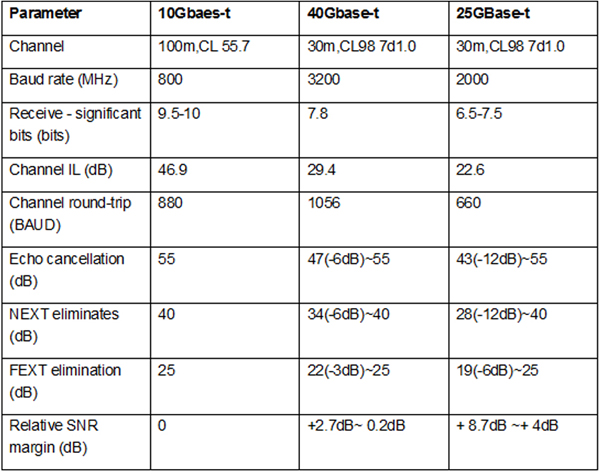
In recent years, 25GBase-T (25G twisted-wire Ethernet) technology has become a popular technology in cloud computing data center due to its high port density and low power consumption and network deployment cost. 25GBase-T delivers 25Gbps over a single channel, supports higher bandwidth Ethernet upgrades, and is suitable for data centers and server rooms. This article will give a comprehensive introduction to 25Gbase-T.
25G Base-T standard and technology
Developed by IEEE in 2016, the 25GBase-T standard enables 25Gbps data transmission over twisted pair wires. 25GBase-T technology is based on 10gBase-T technology and is compatible with 10Gbase-T. After continuous development, it can be compatible with 40Gbase-T. The parameter comparison of 10G/25G/ 40gbase-T technology is shown in the table below. By comparison, it can be found that the complexity of 25GBase-T technology is similar to that of 10Gbase-T technology. Meanwhile, 25Gbase-T follows the 40Gbase-T technology developed earlier, which will effectively reduce the complexity of 25Gbase-T equipment and shorten the time to market. In addition to using SerDes, 25GBase-T also USES the gigabit connection unit interface specification and the SFP28 protocol.

What are the advantages of 25GBase-T?
Why is 25GBase-T so popular in such a short time? There are mainly the following reasons:
1. Excellent output/input capability and structure capability
25GBase-T expands bandwidth capacity economically and efficiently to meet the needs of cloud data centers and next-generation data center servers and storage devices. 25GBase-T can realize 25Gbps transmission by using a single channel. Compared with 10Gbase-T, it improves network bandwidth performance by 2.5 times. At the same time, 25GBase-T can provide four times the switching port density for each switching chip, with higher port density and better scalability compared with 40GBase-T.
2. Use of automatic negotiation and high compatibility
Switches that follow the 25GBase-T standard have ports that automatically recognize transmission rates and create links at the same rate, greatly simplifying network upgrades and effectively reducing connection costs through industry-standard interoperability specifications. Currently, common interoperability specifications include 10Gbase-T, 40Gbase-T, 50Gbase-T and 100gbase-T. 25GBase-T is backward compatible with 10gbase-T, and forward compatible (e.g. 100G Ethernet) can be provided through automatic negotiation, which undoubtedly improves connection efficiency and saves costs.
3. Flexible topology
From the above, 25Gbase-T combined with Cat8 network jumper can achieve 30 meters of data transmission. Compared with 25G DAC high-speed cable, 25GBase-T has a long transmission distance, so 25GBase-T can support more topology wiring, such as the connection between cabinet and cabinet or between EoR switch and server, as well as MOR wiring. For this reason, 25GBase-T is seen by most large cloud data centers as an effective solution for managing switches in hundreds of cabinets.
Note: The transmission distance of 25G DAC high-speed cable is 5~7 meters, which is mainly used to connect the switch and server (in the same cabinet) in ToR topology.
The application of 25GBase -t
As mentioned above, the application of 25GBase-T is similar to that of 40GBase-T. The biggest advantage of 25GBase-T is that it can use Cat8 network jumper to realize the transmission with a distance up to 30m, filling the gap of short distance transmission, especially suitable for MoR and EoR cabling. Therefore, 25Gbase-T is widely used in the connection of switch to server in cloud data center. To learn more about 25GBase-T and 40Gbase-T applications, visit Cat8 Network Jumper for 25/40GBase-T. It turns out that 25GBase-T is suitable for data centers with a variety of network architectures, such as the FatTree architecture, the ridge leaf architecture, and the traditional three-tier architecture.
Conclusion
Today, 25GBase-T is highly touted in the industry for its excellent network bandwidth performance and high scalability and compatibility. 25GBase-T is often used to upgrade from 10G to 100G or higher because it provides a cost-effective path for networks to upgrade to 100G or higher due to its technical advantages (no rewiring). At the same time, 25GBase-T is suitable for MoR and EoR cabling architectures, resulting in significant savings in cabling and administration costs. All in all, 25GBase-T is the best solution for cloud data centers and server rooms.
